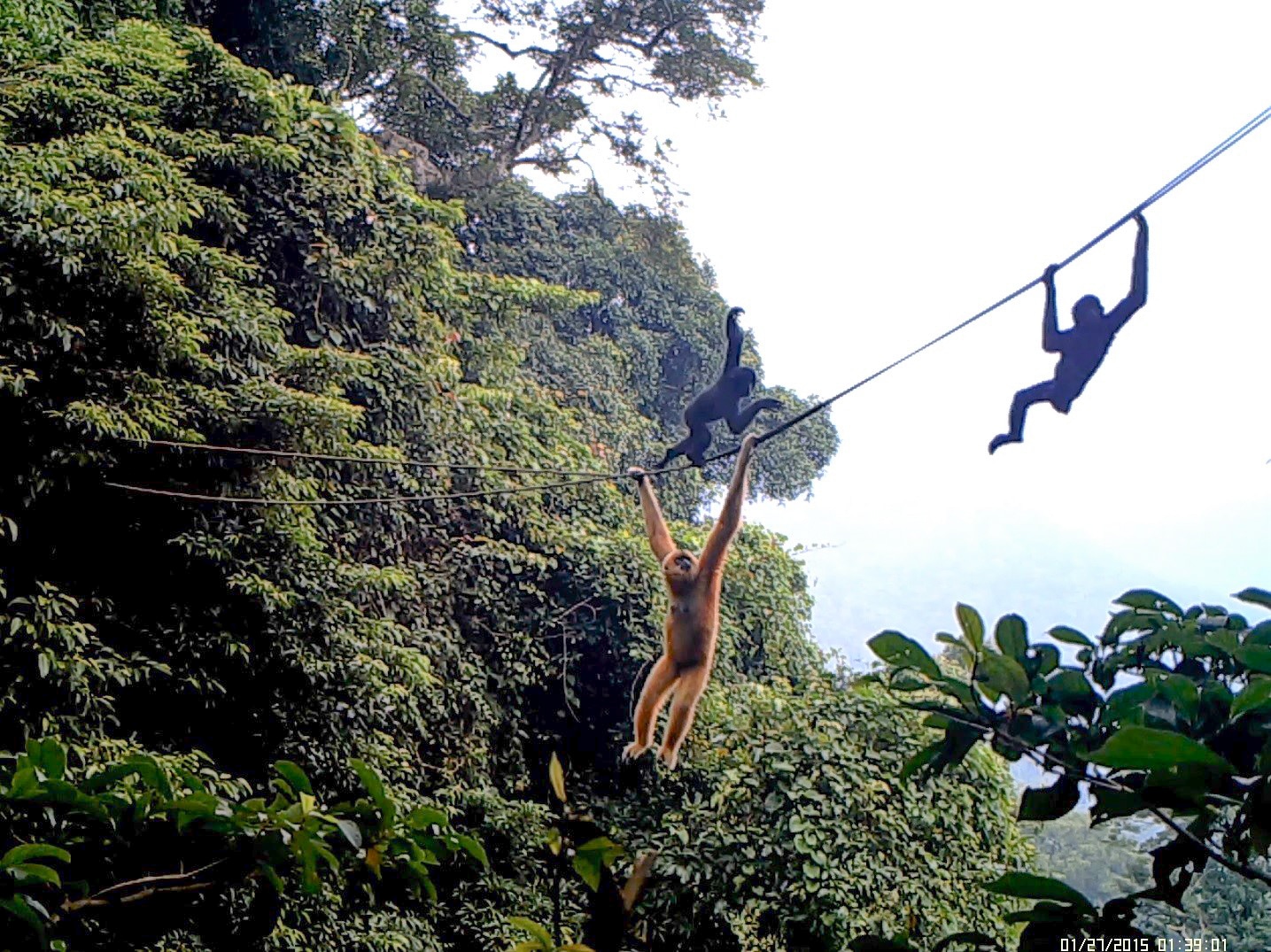While our world was being turned upside down by the COVID-19 pandemic, 2020 was a good year for the world’s rarest primate: the Hainan gibbon.
The Hainan gibbon lives only in the tropical rainforest of its namesake island in the South China Sea. Their unique, haunting, full-throated serenades – sung to woo, to fortify family bonds or to advertise their territory – were once heard across the island, but habitat loss and rampant poaching in the last few decades almost drove the species to extinction, silencing their spellbinding ballads.
Since 2003, our team at the Kadoorie Farm and Botanic Garden (KFBG), a Hong Kong-based nature conservation NGO, has been collaborating with the Hainan Bawangling National Nature Reserve, the last remaining sanctuary for the Hainan gibbon, to save the species from the brink of extinction. After years of hard work and dedication, we were delighted to see 2020 bring us not one, not two, but three positive news about the Hainan gibbon!

A couple of Hainan gibbons (Photo by Kadoorie Farm and Botanic Garden)
Making a strong comeback
In the 1950s, it was estimated that there were more than 2,000 Hainan gibbons in the island’s forests, but with ensuing logging and hunting pressures, their numbers hit a record low in the 1970s, with less than 10 individuals recorded at the time. When KFBG stepped in and conducted the first systematic population survey in 2003, little had changed: a mere 13 individuals living in two family groups was recorded.
To pull the species back from the brink of extinction, we launched an ambitious conservation programme: funding and training three gibbon monitoring teams, organizing anti-poaching patrols, sponsoring researchers, conducting annual gibbon population census, planting the species’ favourite native food trees to restore degraded lowlands, promoting sustainable agriculture and raising awareness in the surrounding communities.
Last year, we confirmed that the population rebounded to 33 individuals living across five family groups. This might not sound like a lot – it’s only the equivalent of three football teams – but given that the species only reproduce every two to three years and only give birth to one baby at a time, the fact that their numbers are slowly and steadily going up is very encouraging.

KFBG works with Bawangling to conduct a Hainan gibbon population survey annually. The survey team, made up of 40 to 50 people, typically spends five days camping in the heart of the gibbon forest, listening out for the species’ characteristic song at dawn, then tracking them down to count their numbers. (Photo by Kadoorie Farm and Botanic Garden)

KFBG promotes sustainable agriculture practices, such as rubber analogue agroforestry and eco-beekeeping. The programme takes place in Qingsong Township, the closest settlement to the Hainan gibbon, to reduce villagers’ reliance on the forest, thus reducing disturbances to the gibbons. (Photo by Kadoorie Farm and Botanic Garden)
New family, new home, new member
For a long time, a 16km2 fragment of primary forest at Bawangling was the last refuge for the Hainan gibbon. So, when our community rangers told us that a pair of Hainan gibbons not only “tied the knot” but also welcomed their first child last year in a “new forest” beyond their long-time territory, we were delighted.
Their newfound home, a mosaic of secondary and primary forest, was once separated from their range by a valley of pine plantations and fire-maintained grassland. After the establishment of the nature reserve in 1980, natural succession quickly followed suit. With the valley no longer an impassable barrier, the new family group must have travelled through the emerging young forest to explore this new habitat. The fact gibbons are able to use secondary forest and expand their range is also an encouraging sign for their long-term survival.

Each family of Hainan gibbon consists of one male, two females and their immature offspring. (Photo by Kadoorie Farm and Botanic Garden)
A bridge of hope
When Super Typhoon Rammasun (the strongest in modern Chinese history) swept over Hainan in 2014, landslides carved deep gullies throughout Bawangling and forced Hainan gibbons to make death-defying leaps across these chasms. For a while, the gibbons relied on a palm frond to break their fall, but it could only take their weight for so long before fraying and sagging. At this point, we decided to intervene and create a safer route for them.
We teamed up with professional tree climbers, who kindly volunteered their expertise to restore the arboreal highway by installing a simple, low-cost canopy bridge made of two parallel mountaineering-grade ropes. Would the gibbons go for it? We put camera traps at both ends of the canopy bridge to see…

One of the professional tree climbers prepares to construct the canopy bridge to link the damaged forests. (Photo by Kadoorie Farm and Botanic Garden)

Gibbons resort to inventive solutions to cross the canopy bridge (Photo by Kadoorie Farm and Botanic Garden)
This year, we detailed our findings in a paper published in Nature journal’s Scientific Reports. Although we found that it took the gibbons nearly six months to “learn the ropes”, once they did, they started taking the canopy bridge more and more frequently. Females and juveniles are the top users, while the more well-built males insisted on performing their “flying” manoeuvres.
Although our contraption worked, we see it more as a temporary fix while we wait for the vegetation to regenerate and the native tree saplings we planted underneath the canopy bridge to grow up. Since late 2018, these trees have also been providing a natural crossing for the gibbons.
All in all, we are glad that despite remaining the rarest primate on earth, the Hainan gibbon is the only gibbon species shown to have a stable population, according to the IUCN Red List – all 19 other species are experiencing population declines.

